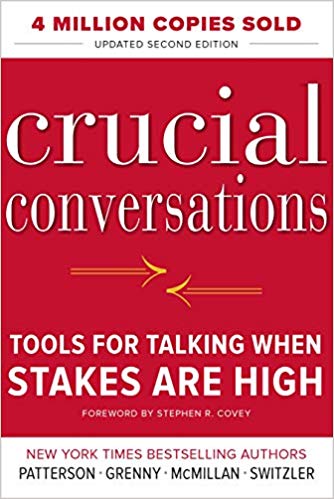

This article is an excerpt from the Shortform summary of "Crucial Conversations" by Kerry Patterson. Shortform has the world's best summaries of books you should be reading.
Like this article? Sign up for a free trial here .
Do you find yourself getting defensive during difficult conversations? Do you want to know how to stop being defensive?
Learning how to stop being defensive is difficult—often, being defensive is a natural reaction to dealing with vulnerabilities. But with practice, you can hone your communication skills and take steps to learn how to stop being defensive.
Why Do People Get Defensive?
What are the steps to learning how to stop being defensive? The first prerequisite for healthy dialogue is safety. You can’t have constructive dialogue when people don’t feel safe, because they start acting in unproductive ways and stop contributing their information to the shared pool.
To maintain safety in a conversation, you must consider two elements: what is being discussed and what’s happening in response — both the content and the conditions of the conversation. This is how you learn how to stop getting defensive.
Most people focus on the content, but the conditions are equally important.
- If conditions are safe, you can say almost anything and people will listen.
- If you’re not afraid you’re being attacked, you can hear almost anything and not become defensive. People rarely become defensive because of what you’re saying (content), only when they don’t feel safe.
- You’re receptive to potentially threatening feedback when you believe the other person has your best interests in mind and you respect their opinion. You trust their motives and don’t feel a need to defend yourself. Conversely, if you don’t feel safe, you can’t take any feedback. You suspect even well-intentioned comments (“What do you mean by saying I look good?”).
Nonetheless, it’s easy to get caught up in the content and care so much about the subject that you don’t notice what’s happening to the dialogue, which can quickly become unproductive. For instance, you or someone else may be speaking too forcefully; others may feel threatened and shut down, or become increasingly forceful themselves. This isn’t helpful in understanding how to stop being defensive.
You need to monitor both content (the topic) and conditions (what people are doing in response) simultaneously. Look at what and why: People are getting upset. Why is this happening? While you can’t just suddenly stop and teach them how to stop getting defensive, you can change the conditions of the conversation.
How to Keep From Getting Defensive
So, if you think you get defensive, you probably want to know how to stop being defensive. The steps for keeping conditions safe are:
- Spot the turning point: Notice when the conversation becomes crucial.
- Watch signs of a safety problem.
- See if others are moving toward silence or violence.
- Beware of reverting to your style under stress.
Ensuring safety
- When things get tense, I try to find out why people are upset.
- When others misunderstand me and get defensive, I quickly clarify what I mean by using contrasting (what I don’t and do mean).
Exploring others’ paths
- When others hesitate to share their views, I listen more intently.
- After I share strong opinions, I urge others to share opposing views.
Controlling your emotions
- When others misunderstand me and get defensive, I clarify what I mean by using contrasting (what I don’t and do mean).
- When I get upset about something and start blaming others, I stop and ask myself how I contributed to the situation.
Using Clever Stories
One important part of learning how to stop being defensive is being aware of your stories. Our stories serve an important part of the conversation process, and being aware of the kind of stories you’re telling can help you know how to stop getting defensive.
Our stories fall into one of two categories:
- Accurate stories that motivate constructive behavior.
- Inaccurate stories that justify our current behavior so there’s no need to change.
The second category comprises clever stories, which allow us to feel good about behaving badly.
They often start with a sellout — an instance in which we’ve consciously acted against what we know is right. For example, our sellout may be that we refused to let someone merge into traffic when we should have. After the fact, we tell a story characterizing the other person as a bad driver to justify our rude behavior.
Other common sellouts:
- You should help someone but you don’t.
- You should apologize but don’t.
- You should listen but become defensive instead.
- You recognize problems but don’t speak up.
You can either own up to your sellout or try to justify it. Instead of admitting errors, we often tell clever stories to justify them.
What are the types of clever stories? You need to know them to know how to avoid being defensive. Clever stories take three basic forms.
1. Victim stories — It’s not my fault: With victim stories, you portray yourself as innocent. Someone else did something and you’re suffering as a result.
Sometimes, you may an innocent victim, but more often you intentionally ignore the role you played in the problem. You tell your story in a way that avoids addressing what you did that might have contributed to the problem.
For example, you complain that your boss disrespected you or treated you unfairly when she took you off a big project. But you neglect to acknowledge that you contributed to the situation by not letting her know you were behind on the work, leaving her in the lurch.
2. Villain stories — It’s someone else’s fault: You may also create stories that portray others as villains. You exaggerate your own innocence by overemphasizing the other person’s guilt or stupidity.
For example, You might describe a boss who is gung ho about quality as a control freak who likes to make employees miserable, rather than acknowledge making mistakes yourself. Labeling (e.g. control freak) is common in villain stories. It’s a way of dehumanizing people, so you feel OK about attacking them.
Victim and villain stories reflect a double standard — when you make a mistake, you’re a victim; when others make mistakes they’re villains for inconveniencing or hurting you.
3. Helpless stories: You portray yourself as powerless to do anything constructive. You convince yourself you have no good alternatives, which justifies your actions.
For example, you might say: “If I didn’t yell, he wouldn’t listen,” or “If I confronted the boss, she’d get angry at me.”
Victim and villain stories explain why we’re in the situation we’re in. Helpless stories explain why we can’t do anything to change our situation.
Helpless stories often grow from villain stories and offer fool’s choices — we can be honest and ruin the relationship or stay silent and suffer. We attribute unchangeable traits to others. For example, we claim that because a colleague is a control freak (villain story), we can’t give her feedback; control freaks can’t handle it. We can’t change that (helpless story).
Why We Resort to Clever Stories
As you learn how to avoid being defensive, you have to be aware of when you’re telling clever stories and why.
- Sometimes they’re true — we really are an innocent victim or maybe we really can’t do much to change the situation.
- Clever stories excuse us from any responsibility, when we are partially responsible.
- We can’t admit we’re wrong: Instead, we emphasize others’ faults and our innocence and powerlessness.
- We did something we feel a need to justify. We sold out in some way, by acting against our own good judgment or conscience.
If you simply mention the facts, the other person may not understand the implications. For example, if you tell an employee, “I noticed you had company software in your briefcase,” they may not understand that you’re talking about a potential policy violation. You have to follow-up that observation with your conclusions.
It’s the combination of facts plus the conclusion there’s a problem that requires face-to-face discussion. When you tell your story, remind yourself it’s a part of knowing how to avoid being defensive and remember:
- Take the risk: When you move from the facts to your conclusions, others can become defensive. But it’s necessary to take the risk.
- Be confident: It takes confidence to share a potentially upsetting story. However, if you’ve objectively examined the facts, you’ll come to a reasonable conclusion that deserves a hearing. You can be confident in adding important, though controversial, meaning to the pool.
- Be selective: Don’t just unload a pile of negative conclusions. Revise your villain story, so you can start in a non-threatening way: “My first reaction was to oppose your recommendation, but after thinking about it I realize I need to know more…”
- Be alert to safety problems: As you share your story, watch for signs that others are feeling threatened. If people get defensive, restore safety by contrasting what you don’t want and what you do want. But don’t minimize your message — be confident enough to speak your mind.
Nobody is perfect, and learning how to stop being defensive takes time. But you can learn skills and tools to help you recognize when you or someone else is being defensive, and you can build better communication.

———End of Preview———
Like what you just read? Read the rest of the world's best summary of Kerry Patterson's "Crucial Conversations" at Shortform .
Here's what you'll find in our full Crucial Conversations summary :
- How to approach an argument without getting mad
- The mistakes most people make when trying to listen to someone else
- How to come up with win-win solutions that make everyone happy






